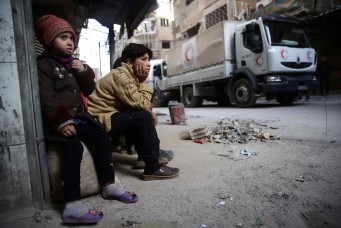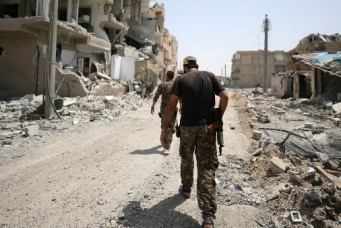Syria: The Fall of the House of Assad
Examining the rise and fall of Bashar Al-Assad.
Syria: The Fall of the House of Assad. By David W. Lesch. Yale University Press, 2012. 288 pp.
“Whether or not he remains in power, Bashar Al-Assad, in my mind, has already fallen.” That is the assessment of David Lesch, who had the opportunity to visit Damascus for a number of sit-downs with the Syrian president before the Arab Spring. It is also a subtle mea culpa; Lesch forms part of the group of Syria experts who were pulling for Al-Assad after his early promise of reform.
With as close as any American might get to an inside view, Lesch’s Syria: The Fall of the House of Assad, serves as a useful primer on Bashar’s time in power. It chronicles the uprising in Syria as it emerged from the cracks of Baath Party rule, growing from the endemic Syrian complaints that coalesced in the heat of the Arab Spring. In the morass of information and misinformation about Syria, Lesch’s book is a vital anatomy of the uprising and a perceptive profile of one man in power.
How did Al-Assad the unassuming ophthalmologist morph into Al-Assad the authoritarian butcher? The turning point, says Lesch, was his survival of a dual onslaught: the U.S. invasion of Iraq in 2003 and the killing of former Lebanese Prime Minister Rafik Hariri in 2005. Both developments heaped international pressure on Damascus, with thinly veiled threats of regime change. That Al-Assad made it through those episodes bred his hubris. And after his 2007 re-“election,” a referendum on his rule that passed by 97 percent, Al-Assad became a product of his own propaganda. By 2008, Lesch describes Bashar Al-Assad as a man fully believing his own sycophants.
The road to revolution was partly paved by the gutting of the Baathist system that Al-Assad inherited with the death in 2000 of his father Hafez Al-Assad, who had ruled Syria for thirty years. There was a generational rift between the technocrats Bashar appointed to carry out his reforms and the old regime stalwarts of his father’s era, stakeholders in the status quo, who pushed back against change. The clearest battleground in that divide was Syria’s “social market economy,” the Bashar-brand liberalization policy that brought a surge in shopping malls, ATM machines, and shiny consumer goods. I covered this Syrian economic opening for Bloomberg Television in 2010, after a bevy of Wall Street names, including Bill Miller and Barton Biggs, visited the country to sniff out opportunities. What I found, and what they saw, was an upper crust of Syrian society newly able to flaunt its wealth. It was a flourishing wasta-cracy, a system where one’s wasta, Arabic for connections, had become extremely enriching.
For Syria, it posed a challenge beyond the normal social frustrations of inequality. The way liberalization was handled meant that for the first time BMWs were conspicuously cruising Damascus at the same time as lower and middle income Syrians were losing their subsidies and social security blankets. This strained the social contract and left practically nothing of Baath Party ideology: Pan-Arabism had failed, resistance to Israel was trite and frozen, and Syrian socialism was being shredded by the kingpins of the younger Al-Assad’s economic reform.
By the time revolution erupted in March 2011, there was but a brittle regime to hold on to. Its strongest card was popular attachment to the idea of a strong and unified Syria, one that only Al-Assad could conceivably deliver. As protests escalated into civil war, that promise was fulfilled in reverse: as the regime came under threat, it weakened and fractured the country. Syrians nominally live within the same borders they’ve known for a century, but a palpable division is becoming increasingly apparent between the central Sunni heartland of Hama and Homs, the Kurdish north, and the Western enclaves of Al-Assad’s ruling Alawite sect in Lattakia and Tartous.
Lesch sketches out key reminders of what we already know: that barring some sudden about face, Syria faces a drawn out fight, an attrition of forces internal and external. Al-Assad hangs on by creating a “favorable stalemate,” a civil war dominated by superior regime power. Lesch also reminds us that the opposition in exile is seen as illegitimate, while any internal opposition is chopped down before it can rise; Al-Assad diligently picks off all potential opponents.
But still Al-Assad falters, and as Al-Assad falters, Syria festers. And as Syria festers, it throws off sparks that could ignite the entire region. These ramifications were foremost in my mind as I put down Syria: The Fall of the House of Assad. Syria has become another arena for the region’s sectarian boxing match. For Saudi Arabia and the Sunni Gulf, the battle in Syria becomes a jab at Iran, a swipe at Hezbollah.
Lesch points out some yawning hypocrisies in the Arab Spring: the irony of Iran backing the Egyptian and Tunisian protesters against pro-Western governments, yet supporting the Syrian regime’s brutal crackdown on its citizens. Similarly, America calls for the end of Al-Assad while backing the monarch of Bahrain in his clampdown on protesters demanding rights. It is a reminder of how the Arab Spring has become a strategic battle as much as a struggle for freedom. Either way, it has left Syria stuck in a bloody quagmire.
Lara Setrakian is a journalist based in Dubai. She contributes to ABC News, Bloomberg Television, and Monocle. She is the founder of Syria Deeply, an Internet platform for citizen journalists reporting from Syria. On Twitter: @lara.






